Data Analytics Portfolio
VerifiedAdded on 2022/12/16
|14
|4125
|84
AI Summary
This portfolio focuses on data analytics in the context of Tesco, a British multinational company. It covers topics such as process mapping, decision-making, digital transformation, information/data management systems, and the use of big data. The portfolio also explores the opportunities for intelligent tools and systems in data analytics.
Contribute Materials
Your contribution can guide someone’s learning journey. Share your
documents today.
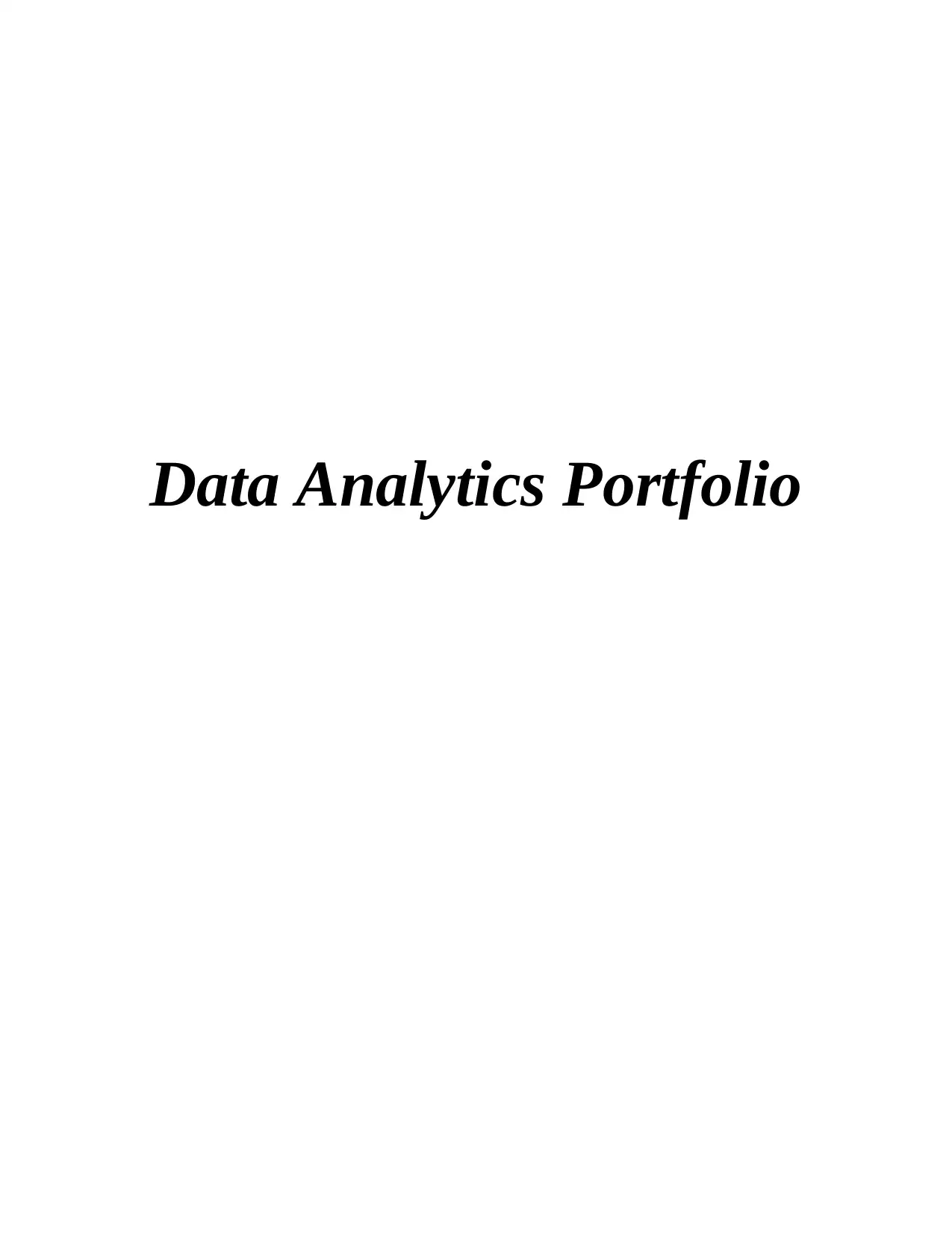
Data Analytics Portfolio
Secure Best Marks with AI Grader
Need help grading? Try our AI Grader for instant feedback on your assignments.
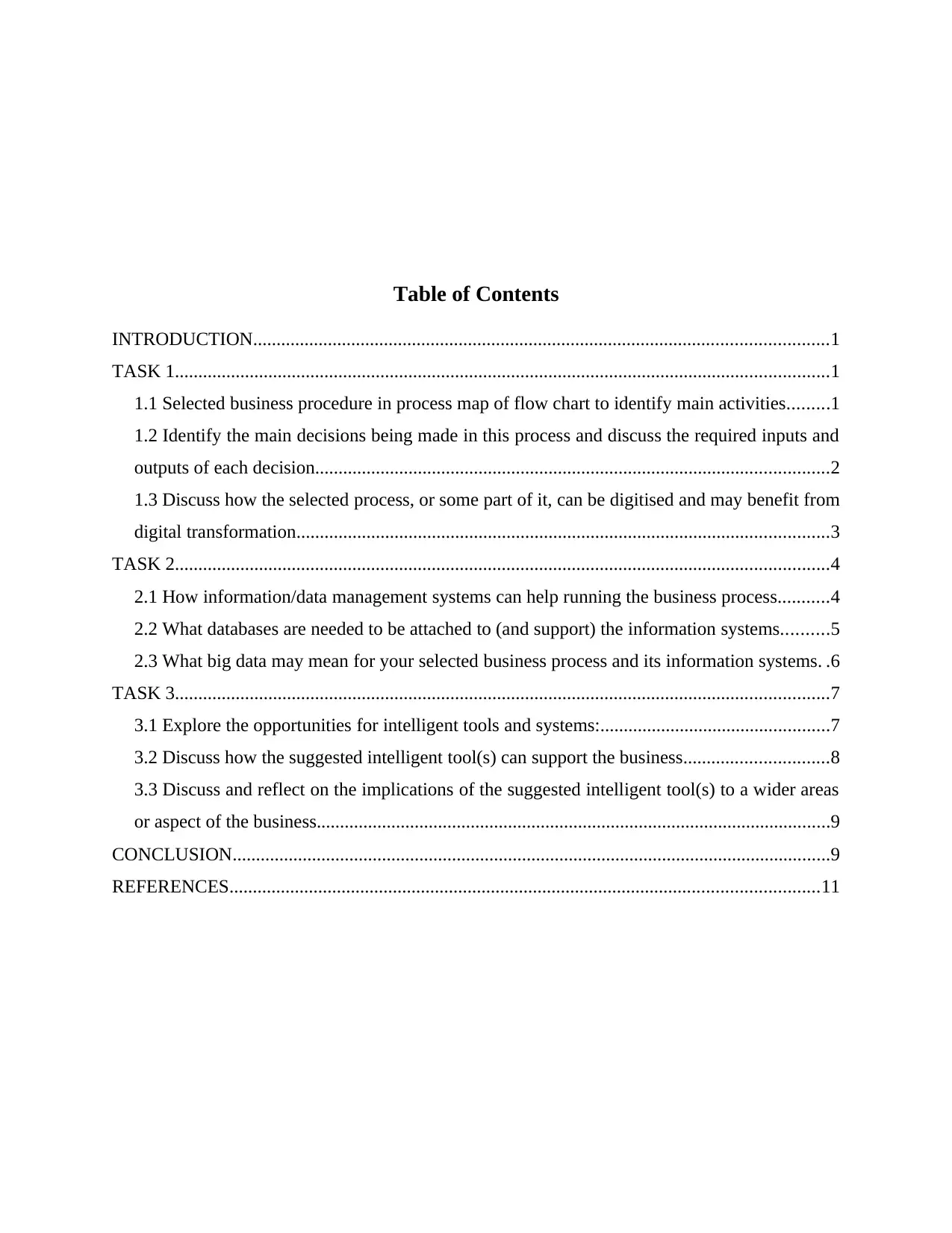
Table of Contents
INTRODUCTION...........................................................................................................................1
TASK 1............................................................................................................................................1
1.1 Selected business procedure in process map of flow chart to identify main activities.........1
1.2 Identify the main decisions being made in this process and discuss the required inputs and
outputs of each decision..............................................................................................................2
1.3 Discuss how the selected process, or some part of it, can be digitised and may benefit from
digital transformation..................................................................................................................3
TASK 2............................................................................................................................................4
2.1 How information/data management systems can help running the business process...........4
2.2 What databases are needed to be attached to (and support) the information systems..........5
2.3 What big data may mean for your selected business process and its information systems. .6
TASK 3............................................................................................................................................7
3.1 Explore the opportunities for intelligent tools and systems:.................................................7
3.2 Discuss how the suggested intelligent tool(s) can support the business...............................8
3.3 Discuss and reflect on the implications of the suggested intelligent tool(s) to a wider areas
or aspect of the business..............................................................................................................9
CONCLUSION................................................................................................................................9
REFERENCES..............................................................................................................................11
INTRODUCTION...........................................................................................................................1
TASK 1............................................................................................................................................1
1.1 Selected business procedure in process map of flow chart to identify main activities.........1
1.2 Identify the main decisions being made in this process and discuss the required inputs and
outputs of each decision..............................................................................................................2
1.3 Discuss how the selected process, or some part of it, can be digitised and may benefit from
digital transformation..................................................................................................................3
TASK 2............................................................................................................................................4
2.1 How information/data management systems can help running the business process...........4
2.2 What databases are needed to be attached to (and support) the information systems..........5
2.3 What big data may mean for your selected business process and its information systems. .6
TASK 3............................................................................................................................................7
3.1 Explore the opportunities for intelligent tools and systems:.................................................7
3.2 Discuss how the suggested intelligent tool(s) can support the business...............................8
3.3 Discuss and reflect on the implications of the suggested intelligent tool(s) to a wider areas
or aspect of the business..............................................................................................................9
CONCLUSION................................................................................................................................9
REFERENCES..............................................................................................................................11
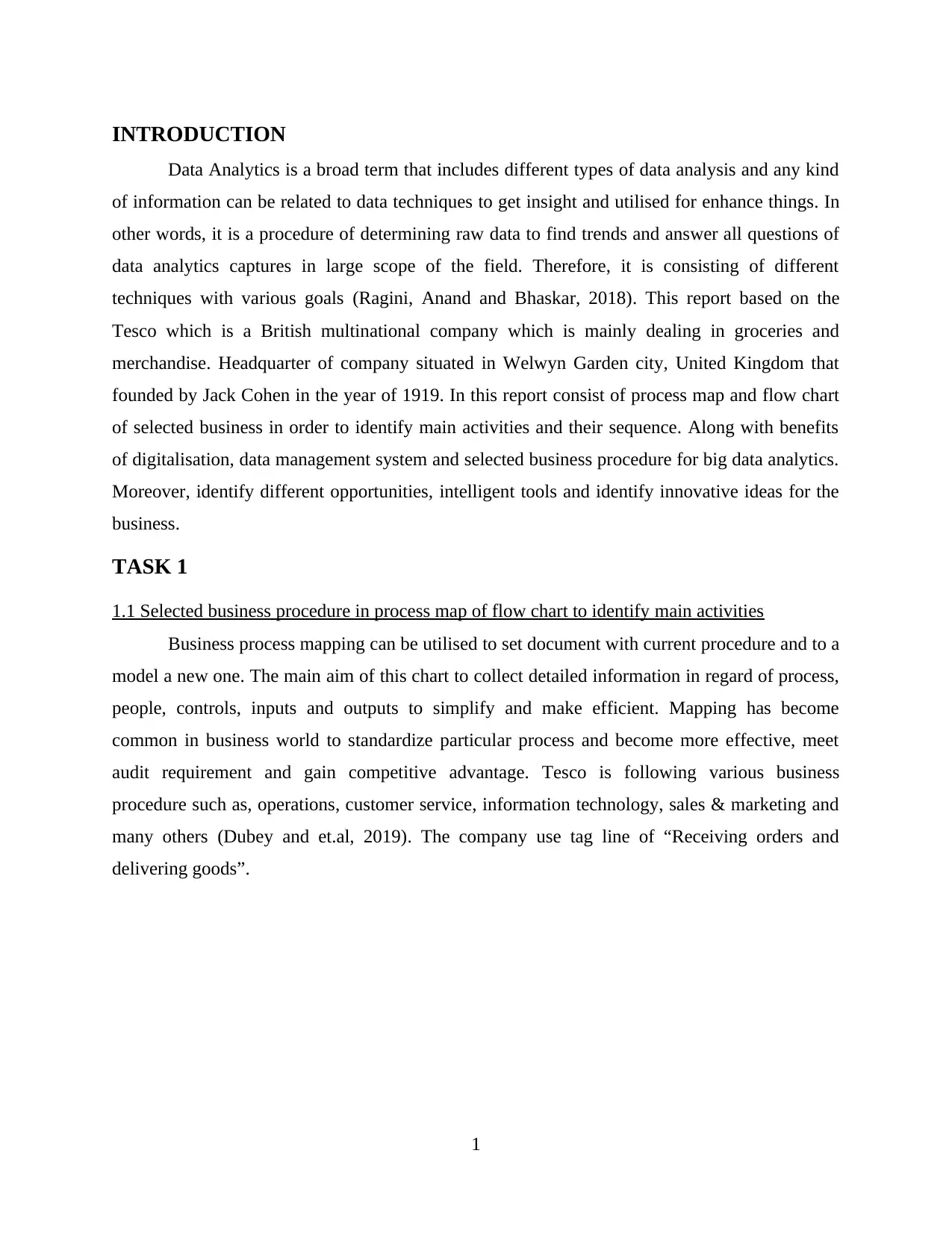
INTRODUCTION
Data Analytics is a broad term that includes different types of data analysis and any kind
of information can be related to data techniques to get insight and utilised for enhance things. In
other words, it is a procedure of determining raw data to find trends and answer all questions of
data analytics captures in large scope of the field. Therefore, it is consisting of different
techniques with various goals (Ragini, Anand and Bhaskar, 2018). This report based on the
Tesco which is a British multinational company which is mainly dealing in groceries and
merchandise. Headquarter of company situated in Welwyn Garden city, United Kingdom that
founded by Jack Cohen in the year of 1919. In this report consist of process map and flow chart
of selected business in order to identify main activities and their sequence. Along with benefits
of digitalisation, data management system and selected business procedure for big data analytics.
Moreover, identify different opportunities, intelligent tools and identify innovative ideas for the
business.
TASK 1
1.1 Selected business procedure in process map of flow chart to identify main activities
Business process mapping can be utilised to set document with current procedure and to a
model a new one. The main aim of this chart to collect detailed information in regard of process,
people, controls, inputs and outputs to simplify and make efficient. Mapping has become
common in business world to standardize particular process and become more effective, meet
audit requirement and gain competitive advantage. Tesco is following various business
procedure such as, operations, customer service, information technology, sales & marketing and
many others (Dubey and et.al, 2019). The company use tag line of “Receiving orders and
delivering goods”.
1
Data Analytics is a broad term that includes different types of data analysis and any kind
of information can be related to data techniques to get insight and utilised for enhance things. In
other words, it is a procedure of determining raw data to find trends and answer all questions of
data analytics captures in large scope of the field. Therefore, it is consisting of different
techniques with various goals (Ragini, Anand and Bhaskar, 2018). This report based on the
Tesco which is a British multinational company which is mainly dealing in groceries and
merchandise. Headquarter of company situated in Welwyn Garden city, United Kingdom that
founded by Jack Cohen in the year of 1919. In this report consist of process map and flow chart
of selected business in order to identify main activities and their sequence. Along with benefits
of digitalisation, data management system and selected business procedure for big data analytics.
Moreover, identify different opportunities, intelligent tools and identify innovative ideas for the
business.
TASK 1
1.1 Selected business procedure in process map of flow chart to identify main activities
Business process mapping can be utilised to set document with current procedure and to a
model a new one. The main aim of this chart to collect detailed information in regard of process,
people, controls, inputs and outputs to simplify and make efficient. Mapping has become
common in business world to standardize particular process and become more effective, meet
audit requirement and gain competitive advantage. Tesco is following various business
procedure such as, operations, customer service, information technology, sales & marketing and
many others (Dubey and et.al, 2019). The company use tag line of “Receiving orders and
delivering goods”.
1
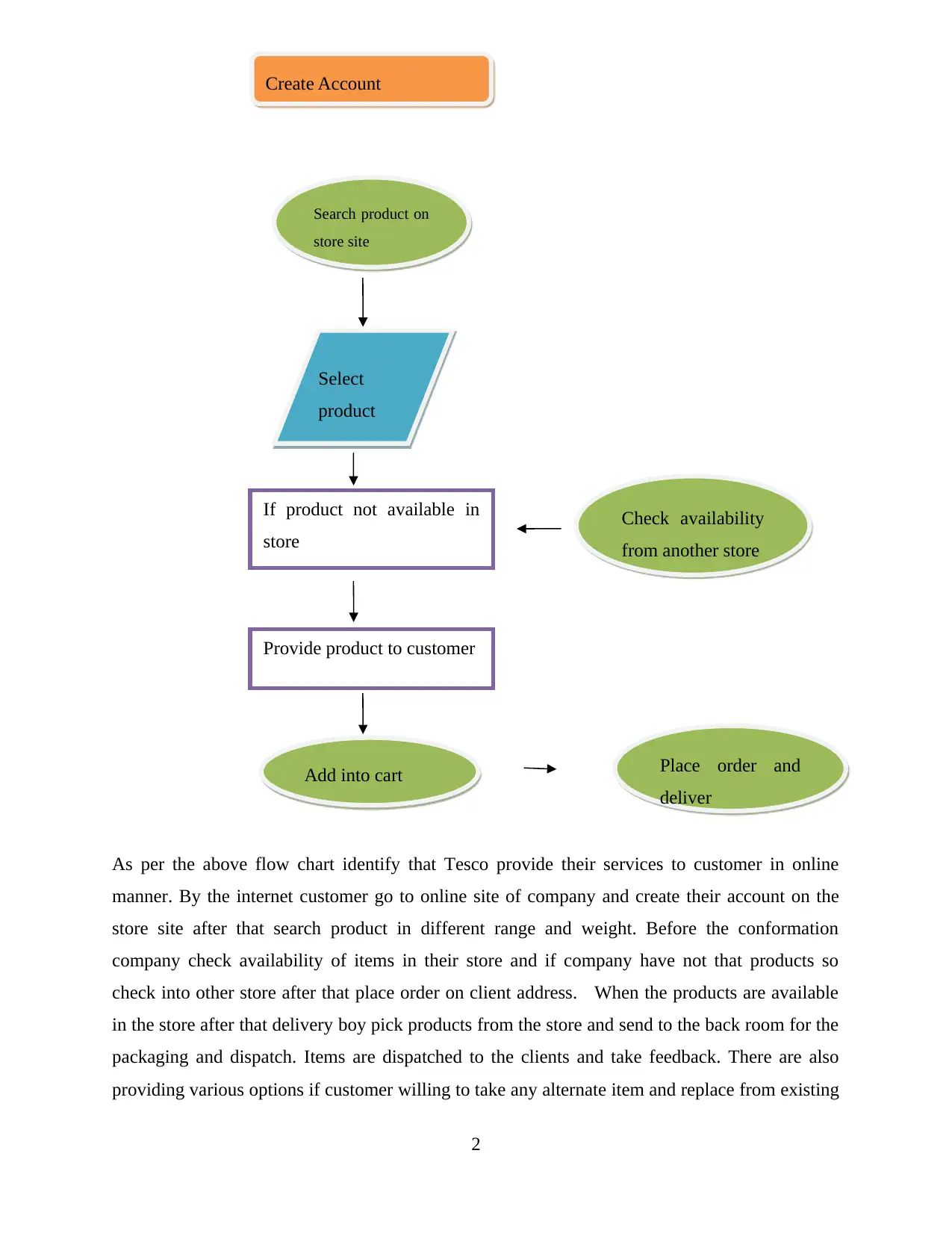
As per the above flow chart identify that Tesco provide their services to customer in online
manner. By the internet customer go to online site of company and create their account on the
store site after that search product in different range and weight. Before the conformation
company check availability of items in their store and if company have not that products so
check into other store after that place order on client address. When the products are available
in the store after that delivery boy pick products from the store and send to the back room for the
packaging and dispatch. Items are dispatched to the clients and take feedback. There are also
providing various options if customer willing to take any alternate item and replace from existing
2
Search product on
store site
Create Account
Select
product
Check availability
from another store
If product not available in
store
Add into cart
Provide product to customer
Place order and
deliver
manner. By the internet customer go to online site of company and create their account on the
store site after that search product in different range and weight. Before the conformation
company check availability of items in their store and if company have not that products so
check into other store after that place order on client address. When the products are available
in the store after that delivery boy pick products from the store and send to the back room for the
packaging and dispatch. Items are dispatched to the clients and take feedback. There are also
providing various options if customer willing to take any alternate item and replace from existing
2
Search product on
store site
Create Account
Select
product
Check availability
from another store
If product not available in
store
Add into cart
Provide product to customer
Place order and
deliver
Secure Best Marks with AI Grader
Need help grading? Try our AI Grader for instant feedback on your assignments.
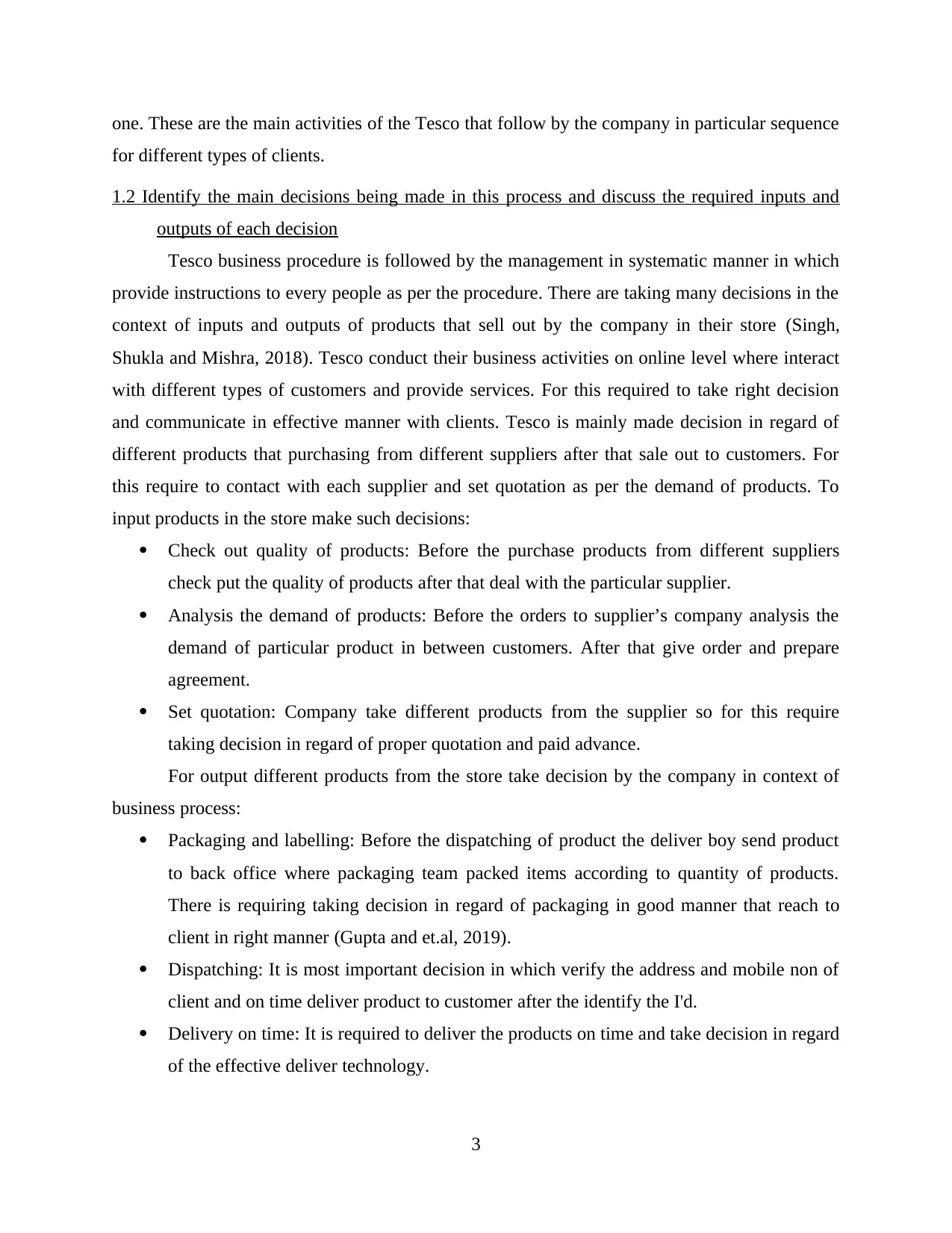
one. These are the main activities of the Tesco that follow by the company in particular sequence
for different types of clients.
1.2 Identify the main decisions being made in this process and discuss the required inputs and
outputs of each decision
Tesco business procedure is followed by the management in systematic manner in which
provide instructions to every people as per the procedure. There are taking many decisions in the
context of inputs and outputs of products that sell out by the company in their store (Singh,
Shukla and Mishra, 2018). Tesco conduct their business activities on online level where interact
with different types of customers and provide services. For this required to take right decision
and communicate in effective manner with clients. Tesco is mainly made decision in regard of
different products that purchasing from different suppliers after that sale out to customers. For
this require to contact with each supplier and set quotation as per the demand of products. To
input products in the store make such decisions:
Check out quality of products: Before the purchase products from different suppliers
check put the quality of products after that deal with the particular supplier.
Analysis the demand of products: Before the orders to supplier’s company analysis the
demand of particular product in between customers. After that give order and prepare
agreement.
Set quotation: Company take different products from the supplier so for this require
taking decision in regard of proper quotation and paid advance.
For output different products from the store take decision by the company in context of
business process:
Packaging and labelling: Before the dispatching of product the deliver boy send product
to back office where packaging team packed items according to quantity of products.
There is requiring taking decision in regard of packaging in good manner that reach to
client in right manner (Gupta and et.al, 2019).
Dispatching: It is most important decision in which verify the address and mobile non of
client and on time deliver product to customer after the identify the I'd.
Delivery on time: It is required to deliver the products on time and take decision in regard
of the effective deliver technology.
3
for different types of clients.
1.2 Identify the main decisions being made in this process and discuss the required inputs and
outputs of each decision
Tesco business procedure is followed by the management in systematic manner in which
provide instructions to every people as per the procedure. There are taking many decisions in the
context of inputs and outputs of products that sell out by the company in their store (Singh,
Shukla and Mishra, 2018). Tesco conduct their business activities on online level where interact
with different types of customers and provide services. For this required to take right decision
and communicate in effective manner with clients. Tesco is mainly made decision in regard of
different products that purchasing from different suppliers after that sale out to customers. For
this require to contact with each supplier and set quotation as per the demand of products. To
input products in the store make such decisions:
Check out quality of products: Before the purchase products from different suppliers
check put the quality of products after that deal with the particular supplier.
Analysis the demand of products: Before the orders to supplier’s company analysis the
demand of particular product in between customers. After that give order and prepare
agreement.
Set quotation: Company take different products from the supplier so for this require
taking decision in regard of proper quotation and paid advance.
For output different products from the store take decision by the company in context of
business process:
Packaging and labelling: Before the dispatching of product the deliver boy send product
to back office where packaging team packed items according to quantity of products.
There is requiring taking decision in regard of packaging in good manner that reach to
client in right manner (Gupta and et.al, 2019).
Dispatching: It is most important decision in which verify the address and mobile non of
client and on time deliver product to customer after the identify the I'd.
Delivery on time: It is required to deliver the products on time and take decision in regard
of the effective deliver technology.
3
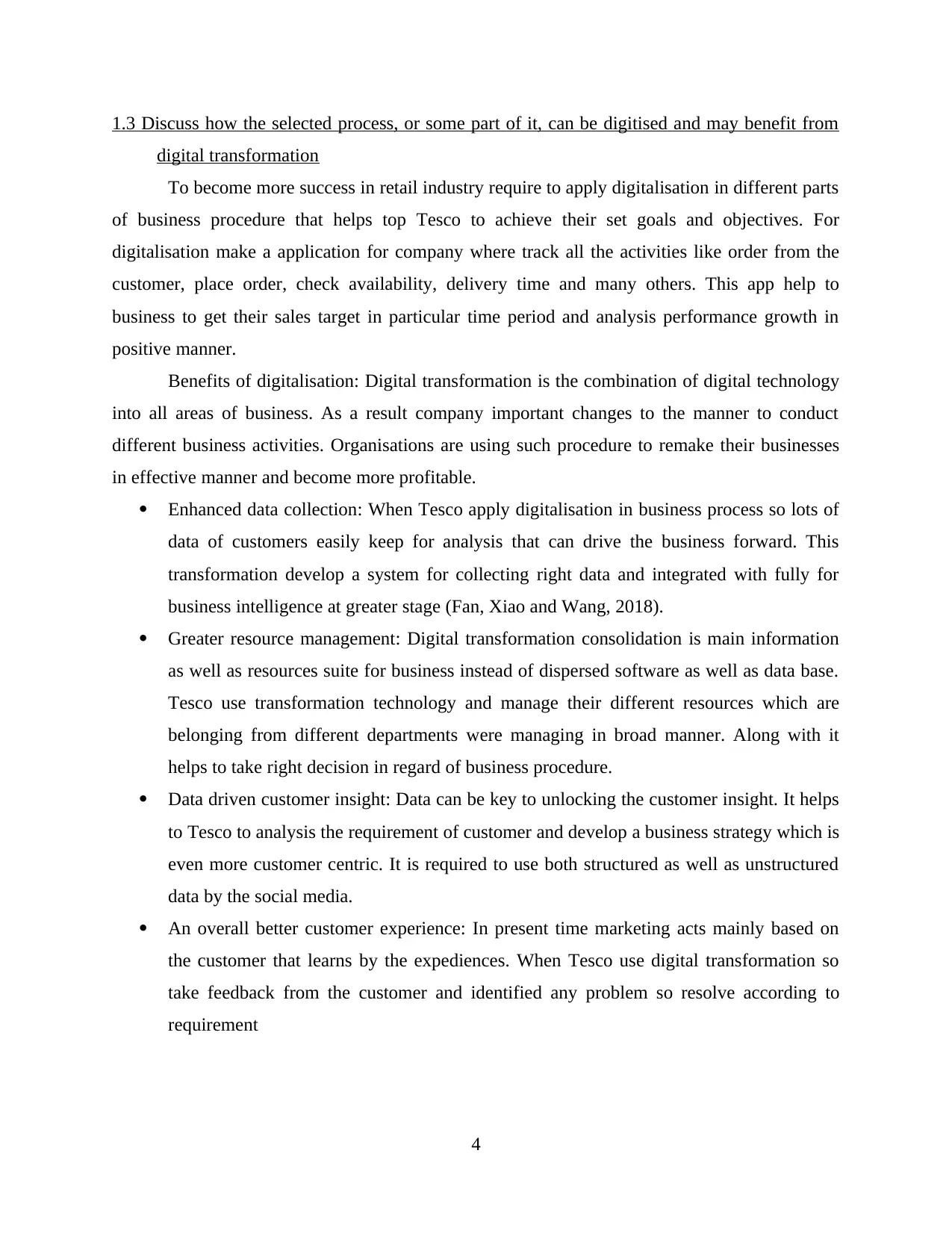
1.3 Discuss how the selected process, or some part of it, can be digitised and may benefit from
digital transformation
To become more success in retail industry require to apply digitalisation in different parts
of business procedure that helps top Tesco to achieve their set goals and objectives. For
digitalisation make a application for company where track all the activities like order from the
customer, place order, check availability, delivery time and many others. This app help to
business to get their sales target in particular time period and analysis performance growth in
positive manner.
Benefits of digitalisation: Digital transformation is the combination of digital technology
into all areas of business. As a result company important changes to the manner to conduct
different business activities. Organisations are using such procedure to remake their businesses
in effective manner and become more profitable.
Enhanced data collection: When Tesco apply digitalisation in business process so lots of
data of customers easily keep for analysis that can drive the business forward. This
transformation develop a system for collecting right data and integrated with fully for
business intelligence at greater stage (Fan, Xiao and Wang, 2018).
Greater resource management: Digital transformation consolidation is main information
as well as resources suite for business instead of dispersed software as well as data base.
Tesco use transformation technology and manage their different resources which are
belonging from different departments were managing in broad manner. Along with it
helps to take right decision in regard of business procedure.
Data driven customer insight: Data can be key to unlocking the customer insight. It helps
to Tesco to analysis the requirement of customer and develop a business strategy which is
even more customer centric. It is required to use both structured as well as unstructured
data by the social media.
An overall better customer experience: In present time marketing acts mainly based on
the customer that learns by the expediences. When Tesco use digital transformation so
take feedback from the customer and identified any problem so resolve according to
requirement
4
digital transformation
To become more success in retail industry require to apply digitalisation in different parts
of business procedure that helps top Tesco to achieve their set goals and objectives. For
digitalisation make a application for company where track all the activities like order from the
customer, place order, check availability, delivery time and many others. This app help to
business to get their sales target in particular time period and analysis performance growth in
positive manner.
Benefits of digitalisation: Digital transformation is the combination of digital technology
into all areas of business. As a result company important changes to the manner to conduct
different business activities. Organisations are using such procedure to remake their businesses
in effective manner and become more profitable.
Enhanced data collection: When Tesco apply digitalisation in business process so lots of
data of customers easily keep for analysis that can drive the business forward. This
transformation develop a system for collecting right data and integrated with fully for
business intelligence at greater stage (Fan, Xiao and Wang, 2018).
Greater resource management: Digital transformation consolidation is main information
as well as resources suite for business instead of dispersed software as well as data base.
Tesco use transformation technology and manage their different resources which are
belonging from different departments were managing in broad manner. Along with it
helps to take right decision in regard of business procedure.
Data driven customer insight: Data can be key to unlocking the customer insight. It helps
to Tesco to analysis the requirement of customer and develop a business strategy which is
even more customer centric. It is required to use both structured as well as unstructured
data by the social media.
An overall better customer experience: In present time marketing acts mainly based on
the customer that learns by the expediences. When Tesco use digital transformation so
take feedback from the customer and identified any problem so resolve according to
requirement
4
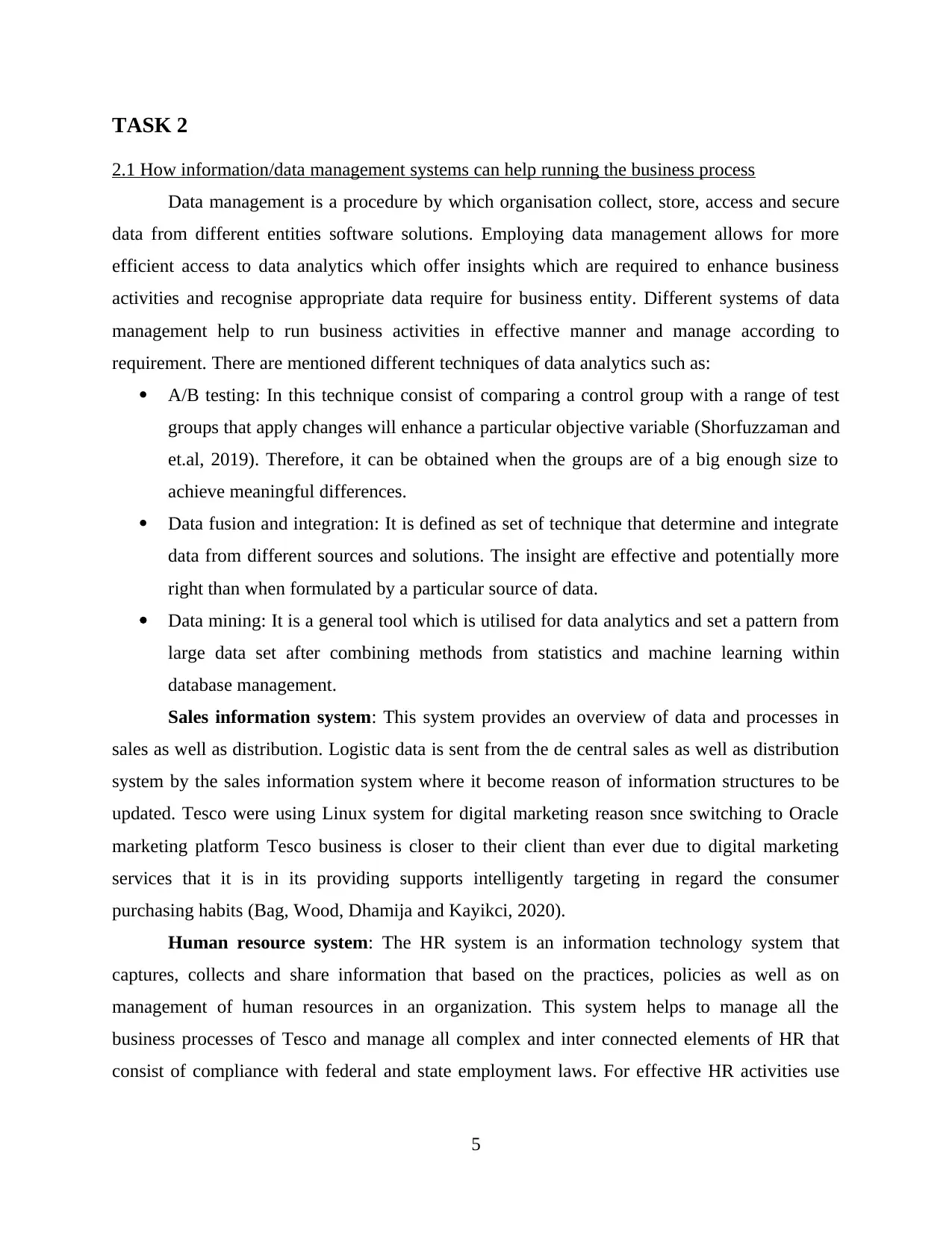
TASK 2
2.1 How information/data management systems can help running the business process
Data management is a procedure by which organisation collect, store, access and secure
data from different entities software solutions. Employing data management allows for more
efficient access to data analytics which offer insights which are required to enhance business
activities and recognise appropriate data require for business entity. Different systems of data
management help to run business activities in effective manner and manage according to
requirement. There are mentioned different techniques of data analytics such as:
A/B testing: In this technique consist of comparing a control group with a range of test
groups that apply changes will enhance a particular objective variable (Shorfuzzaman and
et.al, 2019). Therefore, it can be obtained when the groups are of a big enough size to
achieve meaningful differences.
Data fusion and integration: It is defined as set of technique that determine and integrate
data from different sources and solutions. The insight are effective and potentially more
right than when formulated by a particular source of data.
Data mining: It is a general tool which is utilised for data analytics and set a pattern from
large data set after combining methods from statistics and machine learning within
database management.
Sales information system: This system provides an overview of data and processes in
sales as well as distribution. Logistic data is sent from the de central sales as well as distribution
system by the sales information system where it become reason of information structures to be
updated. Tesco were using Linux system for digital marketing reason snce switching to Oracle
marketing platform Tesco business is closer to their client than ever due to digital marketing
services that it is in its providing supports intelligently targeting in regard the consumer
purchasing habits (Bag, Wood, Dhamija and Kayikci, 2020).
Human resource system: The HR system is an information technology system that
captures, collects and share information that based on the practices, policies as well as on
management of human resources in an organization. This system helps to manage all the
business processes of Tesco and manage all complex and inter connected elements of HR that
consist of compliance with federal and state employment laws. For effective HR activities use
5
2.1 How information/data management systems can help running the business process
Data management is a procedure by which organisation collect, store, access and secure
data from different entities software solutions. Employing data management allows for more
efficient access to data analytics which offer insights which are required to enhance business
activities and recognise appropriate data require for business entity. Different systems of data
management help to run business activities in effective manner and manage according to
requirement. There are mentioned different techniques of data analytics such as:
A/B testing: In this technique consist of comparing a control group with a range of test
groups that apply changes will enhance a particular objective variable (Shorfuzzaman and
et.al, 2019). Therefore, it can be obtained when the groups are of a big enough size to
achieve meaningful differences.
Data fusion and integration: It is defined as set of technique that determine and integrate
data from different sources and solutions. The insight are effective and potentially more
right than when formulated by a particular source of data.
Data mining: It is a general tool which is utilised for data analytics and set a pattern from
large data set after combining methods from statistics and machine learning within
database management.
Sales information system: This system provides an overview of data and processes in
sales as well as distribution. Logistic data is sent from the de central sales as well as distribution
system by the sales information system where it become reason of information structures to be
updated. Tesco were using Linux system for digital marketing reason snce switching to Oracle
marketing platform Tesco business is closer to their client than ever due to digital marketing
services that it is in its providing supports intelligently targeting in regard the consumer
purchasing habits (Bag, Wood, Dhamija and Kayikci, 2020).
Human resource system: The HR system is an information technology system that
captures, collects and share information that based on the practices, policies as well as on
management of human resources in an organization. This system helps to manage all the
business processes of Tesco and manage all complex and inter connected elements of HR that
consist of compliance with federal and state employment laws. For effective HR activities use
5
Paraphrase This Document
Need a fresh take? Get an instant paraphrase of this document with our AI Paraphraser
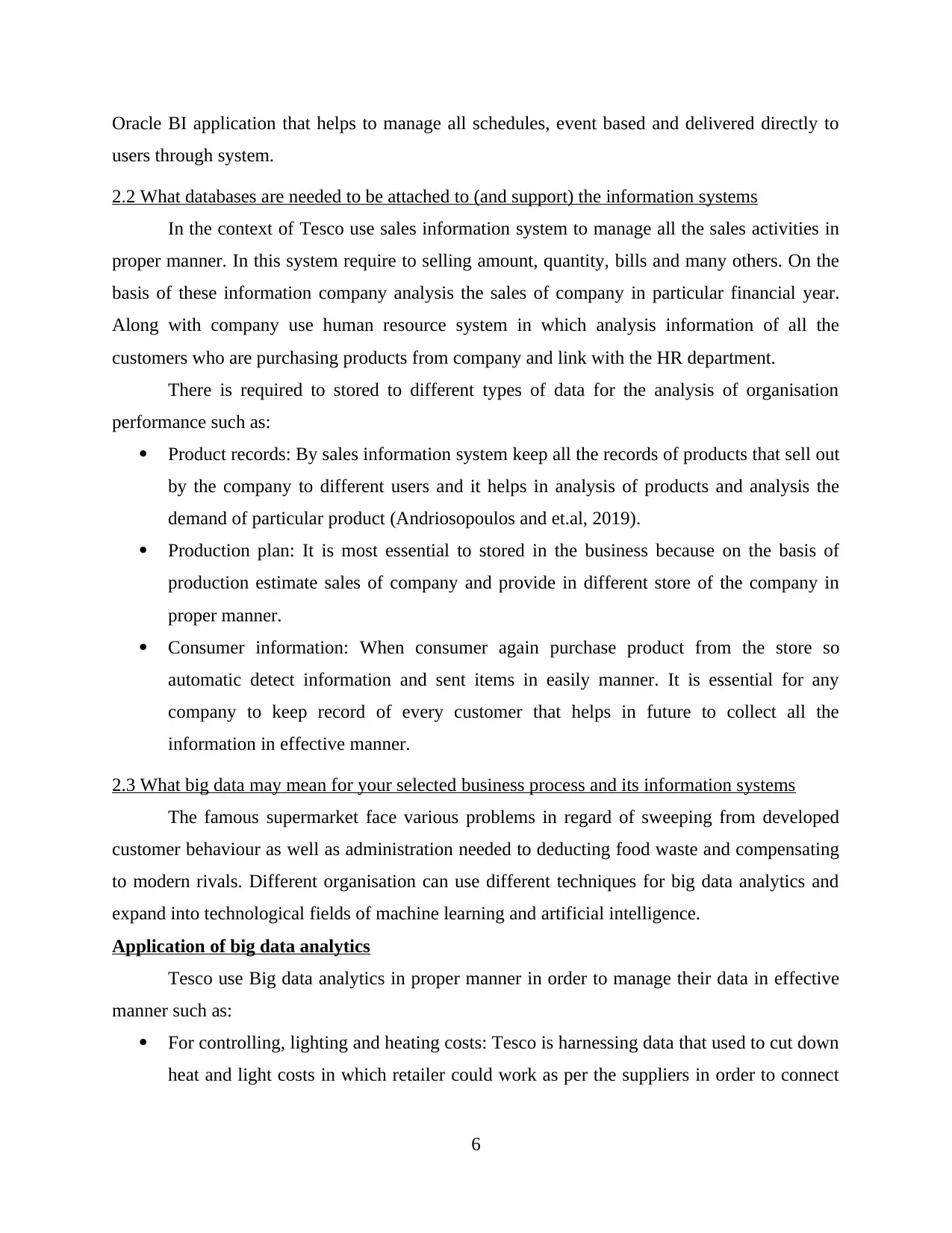
Oracle BI application that helps to manage all schedules, event based and delivered directly to
users through system.
2.2 What databases are needed to be attached to (and support) the information systems
In the context of Tesco use sales information system to manage all the sales activities in
proper manner. In this system require to selling amount, quantity, bills and many others. On the
basis of these information company analysis the sales of company in particular financial year.
Along with company use human resource system in which analysis information of all the
customers who are purchasing products from company and link with the HR department.
There is required to stored to different types of data for the analysis of organisation
performance such as:
Product records: By sales information system keep all the records of products that sell out
by the company to different users and it helps in analysis of products and analysis the
demand of particular product (Andriosopoulos and et.al, 2019).
Production plan: It is most essential to stored in the business because on the basis of
production estimate sales of company and provide in different store of the company in
proper manner.
Consumer information: When consumer again purchase product from the store so
automatic detect information and sent items in easily manner. It is essential for any
company to keep record of every customer that helps in future to collect all the
information in effective manner.
2.3 What big data may mean for your selected business process and its information systems
The famous supermarket face various problems in regard of sweeping from developed
customer behaviour as well as administration needed to deducting food waste and compensating
to modern rivals. Different organisation can use different techniques for big data analytics and
expand into technological fields of machine learning and artificial intelligence.
Application of big data analytics
Tesco use Big data analytics in proper manner in order to manage their data in effective
manner such as:
For controlling, lighting and heating costs: Tesco is harnessing data that used to cut down
heat and light costs in which retailer could work as per the suppliers in order to connect
6
users through system.
2.2 What databases are needed to be attached to (and support) the information systems
In the context of Tesco use sales information system to manage all the sales activities in
proper manner. In this system require to selling amount, quantity, bills and many others. On the
basis of these information company analysis the sales of company in particular financial year.
Along with company use human resource system in which analysis information of all the
customers who are purchasing products from company and link with the HR department.
There is required to stored to different types of data for the analysis of organisation
performance such as:
Product records: By sales information system keep all the records of products that sell out
by the company to different users and it helps in analysis of products and analysis the
demand of particular product (Andriosopoulos and et.al, 2019).
Production plan: It is most essential to stored in the business because on the basis of
production estimate sales of company and provide in different store of the company in
proper manner.
Consumer information: When consumer again purchase product from the store so
automatic detect information and sent items in easily manner. It is essential for any
company to keep record of every customer that helps in future to collect all the
information in effective manner.
2.3 What big data may mean for your selected business process and its information systems
The famous supermarket face various problems in regard of sweeping from developed
customer behaviour as well as administration needed to deducting food waste and compensating
to modern rivals. Different organisation can use different techniques for big data analytics and
expand into technological fields of machine learning and artificial intelligence.
Application of big data analytics
Tesco use Big data analytics in proper manner in order to manage their data in effective
manner such as:
For controlling, lighting and heating costs: Tesco is harnessing data that used to cut down
heat and light costs in which retailer could work as per the suppliers in order to connect
6
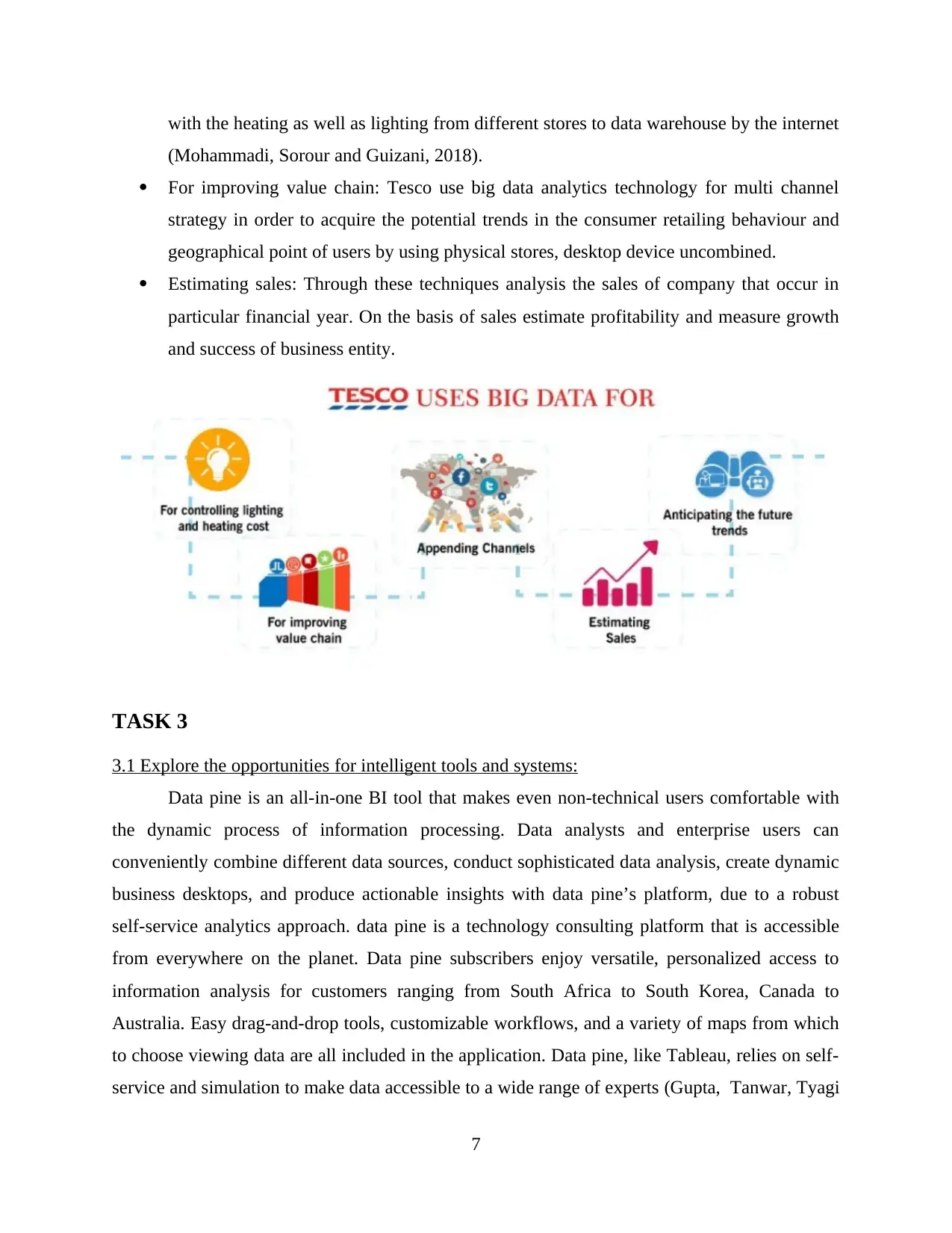
with the heating as well as lighting from different stores to data warehouse by the internet
(Mohammadi, Sorour and Guizani, 2018).
For improving value chain: Tesco use big data analytics technology for multi channel
strategy in order to acquire the potential trends in the consumer retailing behaviour and
geographical point of users by using physical stores, desktop device uncombined.
Estimating sales: Through these techniques analysis the sales of company that occur in
particular financial year. On the basis of sales estimate profitability and measure growth
and success of business entity.
TASK 3
3.1 Explore the opportunities for intelligent tools and systems:
Data pine is an all-in-one BI tool that makes even non-technical users comfortable with
the dynamic process of information processing. Data analysts and enterprise users can
conveniently combine different data sources, conduct sophisticated data analysis, create dynamic
business desktops, and produce actionable insights with data pine’s platform, due to a robust
self-service analytics approach. data pine is a technology consulting platform that is accessible
from everywhere on the planet. Data pine subscribers enjoy versatile, personalized access to
information analysis for customers ranging from South Africa to South Korea, Canada to
Australia. Easy drag-and-drop tools, customizable workflows, and a variety of maps from which
to choose viewing data are all included in the application. Data pine, like Tableau, relies on self-
service and simulation to make data accessible to a wide range of experts (Gupta, Tanwar, Tyagi
7
(Mohammadi, Sorour and Guizani, 2018).
For improving value chain: Tesco use big data analytics technology for multi channel
strategy in order to acquire the potential trends in the consumer retailing behaviour and
geographical point of users by using physical stores, desktop device uncombined.
Estimating sales: Through these techniques analysis the sales of company that occur in
particular financial year. On the basis of sales estimate profitability and measure growth
and success of business entity.
TASK 3
3.1 Explore the opportunities for intelligent tools and systems:
Data pine is an all-in-one BI tool that makes even non-technical users comfortable with
the dynamic process of information processing. Data analysts and enterprise users can
conveniently combine different data sources, conduct sophisticated data analysis, create dynamic
business desktops, and produce actionable insights with data pine’s platform, due to a robust
self-service analytics approach. data pine is a technology consulting platform that is accessible
from everywhere on the planet. Data pine subscribers enjoy versatile, personalized access to
information analysis for customers ranging from South Africa to South Korea, Canada to
Australia. Easy drag-and-drop tools, customizable workflows, and a variety of maps from which
to choose viewing data are all included in the application. Data pine, like Tableau, relies on self-
service and simulation to make data accessible to a wide range of experts (Gupta, Tanwar, Tyagi
7
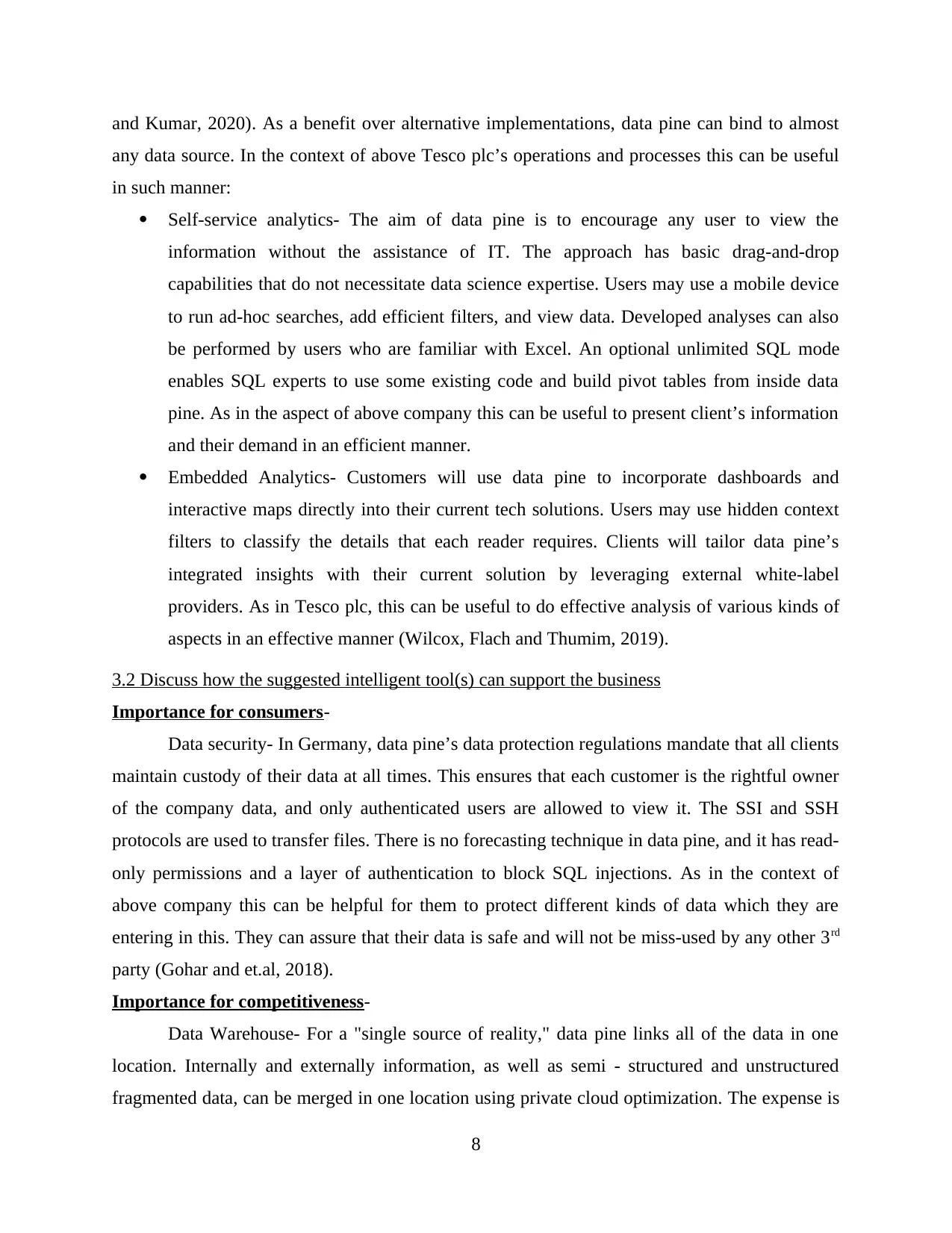
and Kumar, 2020). As a benefit over alternative implementations, data pine can bind to almost
any data source. In the context of above Tesco plc’s operations and processes this can be useful
in such manner:
Self-service analytics- The aim of data pine is to encourage any user to view the
information without the assistance of IT. The approach has basic drag-and-drop
capabilities that do not necessitate data science expertise. Users may use a mobile device
to run ad-hoc searches, add efficient filters, and view data. Developed analyses can also
be performed by users who are familiar with Excel. An optional unlimited SQL mode
enables SQL experts to use some existing code and build pivot tables from inside data
pine. As in the aspect of above company this can be useful to present client’s information
and their demand in an efficient manner.
Embedded Analytics- Customers will use data pine to incorporate dashboards and
interactive maps directly into their current tech solutions. Users may use hidden context
filters to classify the details that each reader requires. Clients will tailor data pine’s
integrated insights with their current solution by leveraging external white-label
providers. As in Tesco plc, this can be useful to do effective analysis of various kinds of
aspects in an effective manner (Wilcox, Flach and Thumim, 2019).
3.2 Discuss how the suggested intelligent tool(s) can support the business
Importance for consumers-
Data security- In Germany, data pine’s data protection regulations mandate that all clients
maintain custody of their data at all times. This ensures that each customer is the rightful owner
of the company data, and only authenticated users are allowed to view it. The SSI and SSH
protocols are used to transfer files. There is no forecasting technique in data pine, and it has read-
only permissions and a layer of authentication to block SQL injections. As in the context of
above company this can be helpful for them to protect different kinds of data which they are
entering in this. They can assure that their data is safe and will not be miss-used by any other 3rd
party (Gohar and et.al, 2018).
Importance for competitiveness-
Data Warehouse- For a "single source of reality," data pine links all of the data in one
location. Internally and externally information, as well as semi - structured and unstructured
fragmented data, can be merged in one location using private cloud optimization. The expense is
8
any data source. In the context of above Tesco plc’s operations and processes this can be useful
in such manner:
Self-service analytics- The aim of data pine is to encourage any user to view the
information without the assistance of IT. The approach has basic drag-and-drop
capabilities that do not necessitate data science expertise. Users may use a mobile device
to run ad-hoc searches, add efficient filters, and view data. Developed analyses can also
be performed by users who are familiar with Excel. An optional unlimited SQL mode
enables SQL experts to use some existing code and build pivot tables from inside data
pine. As in the aspect of above company this can be useful to present client’s information
and their demand in an efficient manner.
Embedded Analytics- Customers will use data pine to incorporate dashboards and
interactive maps directly into their current tech solutions. Users may use hidden context
filters to classify the details that each reader requires. Clients will tailor data pine’s
integrated insights with their current solution by leveraging external white-label
providers. As in Tesco plc, this can be useful to do effective analysis of various kinds of
aspects in an effective manner (Wilcox, Flach and Thumim, 2019).
3.2 Discuss how the suggested intelligent tool(s) can support the business
Importance for consumers-
Data security- In Germany, data pine’s data protection regulations mandate that all clients
maintain custody of their data at all times. This ensures that each customer is the rightful owner
of the company data, and only authenticated users are allowed to view it. The SSI and SSH
protocols are used to transfer files. There is no forecasting technique in data pine, and it has read-
only permissions and a layer of authentication to block SQL injections. As in the context of
above company this can be helpful for them to protect different kinds of data which they are
entering in this. They can assure that their data is safe and will not be miss-used by any other 3rd
party (Gohar and et.al, 2018).
Importance for competitiveness-
Data Warehouse- For a "single source of reality," data pine links all of the data in one
location. Internally and externally information, as well as semi - structured and unstructured
fragmented data, can be merged in one location using private cloud optimization. The expense is
8
Secure Best Marks with AI Grader
Need help grading? Try our AI Grader for instant feedback on your assignments.
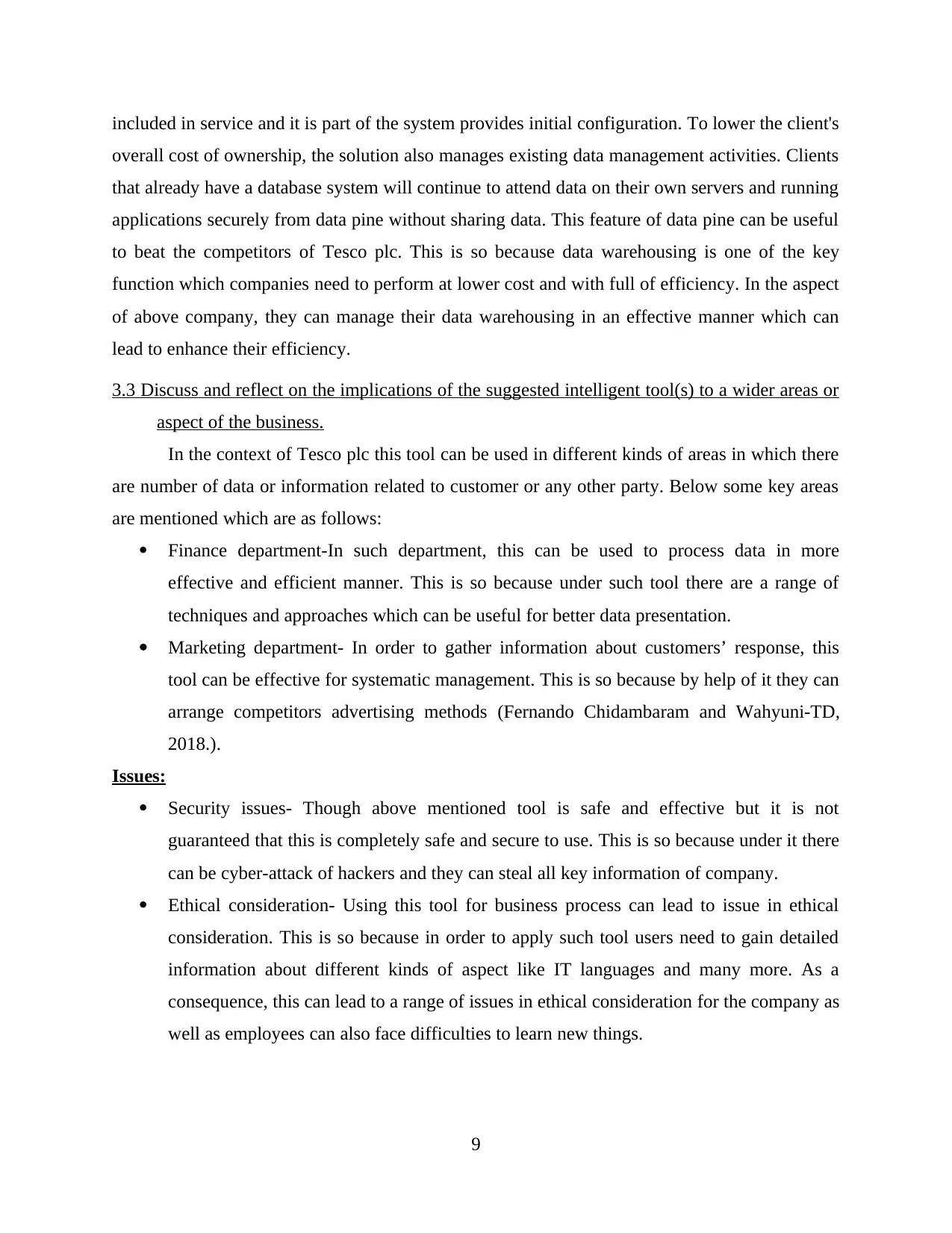
included in service and it is part of the system provides initial configuration. To lower the client's
overall cost of ownership, the solution also manages existing data management activities. Clients
that already have a database system will continue to attend data on their own servers and running
applications securely from data pine without sharing data. This feature of data pine can be useful
to beat the competitors of Tesco plc. This is so because data warehousing is one of the key
function which companies need to perform at lower cost and with full of efficiency. In the aspect
of above company, they can manage their data warehousing in an effective manner which can
lead to enhance their efficiency.
3.3 Discuss and reflect on the implications of the suggested intelligent tool(s) to a wider areas or
aspect of the business.
In the context of Tesco plc this tool can be used in different kinds of areas in which there
are number of data or information related to customer or any other party. Below some key areas
are mentioned which are as follows:
Finance department-In such department, this can be used to process data in more
effective and efficient manner. This is so because under such tool there are a range of
techniques and approaches which can be useful for better data presentation.
Marketing department- In order to gather information about customers’ response, this
tool can be effective for systematic management. This is so because by help of it they can
arrange competitors advertising methods (Fernando Chidambaram and Wahyuni-TD,
2018.).
Issues:
Security issues- Though above mentioned tool is safe and effective but it is not
guaranteed that this is completely safe and secure to use. This is so because under it there
can be cyber-attack of hackers and they can steal all key information of company.
Ethical consideration- Using this tool for business process can lead to issue in ethical
consideration. This is so because in order to apply such tool users need to gain detailed
information about different kinds of aspect like IT languages and many more. As a
consequence, this can lead to a range of issues in ethical consideration for the company as
well as employees can also face difficulties to learn new things.
9
overall cost of ownership, the solution also manages existing data management activities. Clients
that already have a database system will continue to attend data on their own servers and running
applications securely from data pine without sharing data. This feature of data pine can be useful
to beat the competitors of Tesco plc. This is so because data warehousing is one of the key
function which companies need to perform at lower cost and with full of efficiency. In the aspect
of above company, they can manage their data warehousing in an effective manner which can
lead to enhance their efficiency.
3.3 Discuss and reflect on the implications of the suggested intelligent tool(s) to a wider areas or
aspect of the business.
In the context of Tesco plc this tool can be used in different kinds of areas in which there
are number of data or information related to customer or any other party. Below some key areas
are mentioned which are as follows:
Finance department-In such department, this can be used to process data in more
effective and efficient manner. This is so because under such tool there are a range of
techniques and approaches which can be useful for better data presentation.
Marketing department- In order to gather information about customers’ response, this
tool can be effective for systematic management. This is so because by help of it they can
arrange competitors advertising methods (Fernando Chidambaram and Wahyuni-TD,
2018.).
Issues:
Security issues- Though above mentioned tool is safe and effective but it is not
guaranteed that this is completely safe and secure to use. This is so because under it there
can be cyber-attack of hackers and they can steal all key information of company.
Ethical consideration- Using this tool for business process can lead to issue in ethical
consideration. This is so because in order to apply such tool users need to gain detailed
information about different kinds of aspect like IT languages and many more. As a
consequence, this can lead to a range of issues in ethical consideration for the company as
well as employees can also face difficulties to learn new things.
9
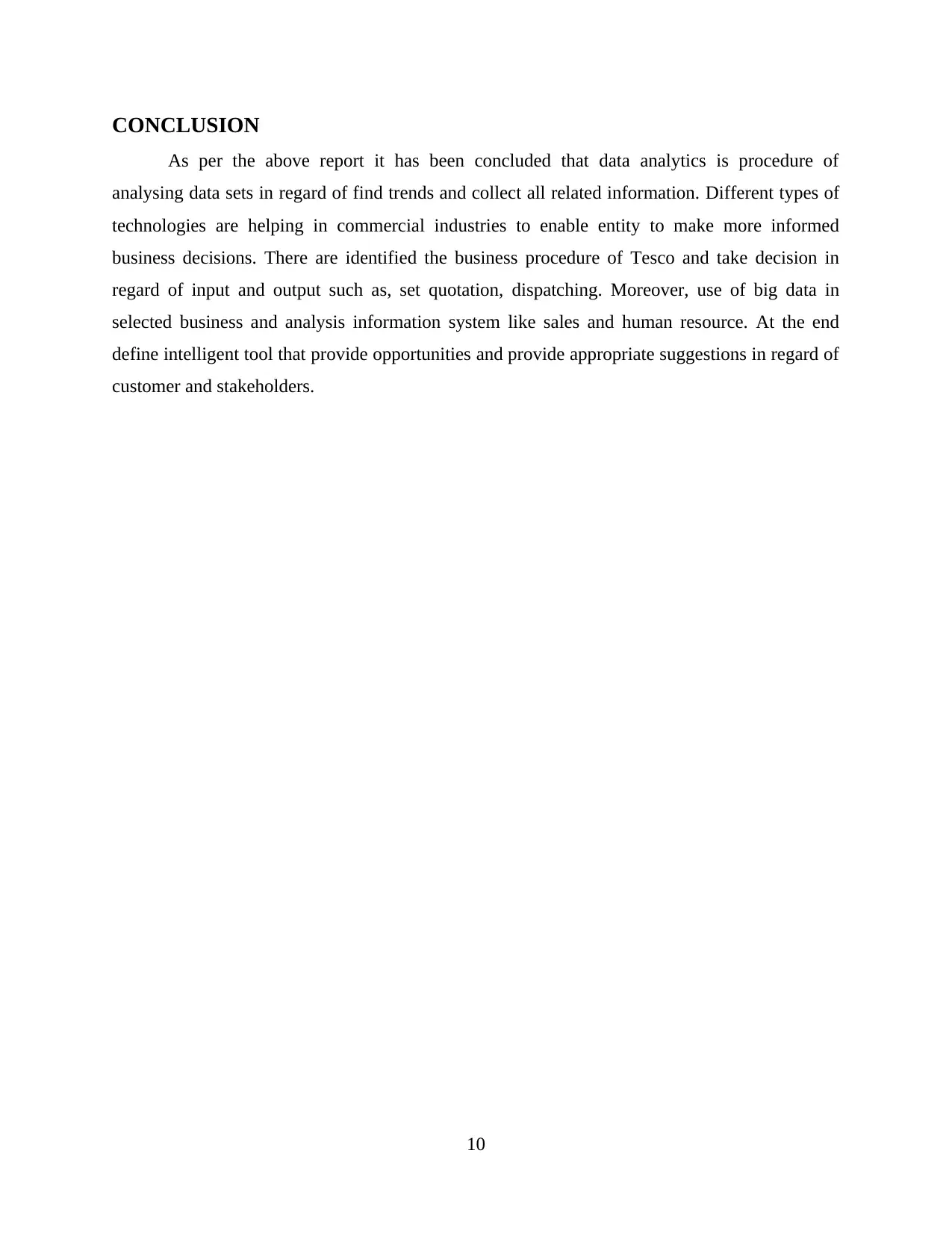
CONCLUSION
As per the above report it has been concluded that data analytics is procedure of
analysing data sets in regard of find trends and collect all related information. Different types of
technologies are helping in commercial industries to enable entity to make more informed
business decisions. There are identified the business procedure of Tesco and take decision in
regard of input and output such as, set quotation, dispatching. Moreover, use of big data in
selected business and analysis information system like sales and human resource. At the end
define intelligent tool that provide opportunities and provide appropriate suggestions in regard of
customer and stakeholders.
10
As per the above report it has been concluded that data analytics is procedure of
analysing data sets in regard of find trends and collect all related information. Different types of
technologies are helping in commercial industries to enable entity to make more informed
business decisions. There are identified the business procedure of Tesco and take decision in
regard of input and output such as, set quotation, dispatching. Moreover, use of big data in
selected business and analysis information system like sales and human resource. At the end
define intelligent tool that provide opportunities and provide appropriate suggestions in regard of
customer and stakeholders.
10
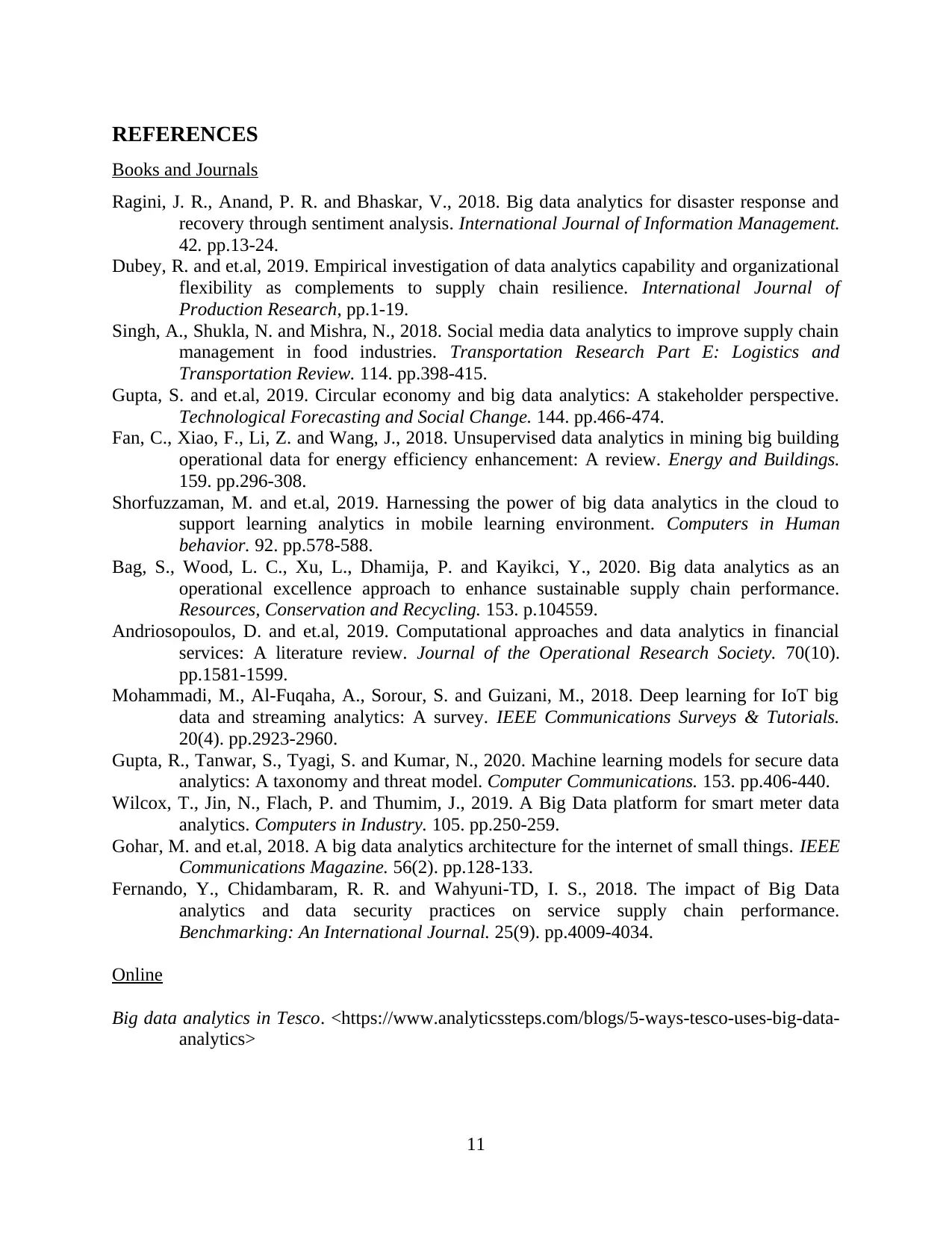
REFERENCES
Books and Journals
Ragini, J. R., Anand, P. R. and Bhaskar, V., 2018. Big data analytics for disaster response and
recovery through sentiment analysis. International Journal of Information Management.
42. pp.13-24.
Dubey, R. and et.al, 2019. Empirical investigation of data analytics capability and organizational
flexibility as complements to supply chain resilience. International Journal of
Production Research, pp.1-19.
Singh, A., Shukla, N. and Mishra, N., 2018. Social media data analytics to improve supply chain
management in food industries. Transportation Research Part E: Logistics and
Transportation Review. 114. pp.398-415.
Gupta, S. and et.al, 2019. Circular economy and big data analytics: A stakeholder perspective.
Technological Forecasting and Social Change. 144. pp.466-474.
Fan, C., Xiao, F., Li, Z. and Wang, J., 2018. Unsupervised data analytics in mining big building
operational data for energy efficiency enhancement: A review. Energy and Buildings.
159. pp.296-308.
Shorfuzzaman, M. and et.al, 2019. Harnessing the power of big data analytics in the cloud to
support learning analytics in mobile learning environment. Computers in Human
behavior. 92. pp.578-588.
Bag, S., Wood, L. C., Xu, L., Dhamija, P. and Kayikci, Y., 2020. Big data analytics as an
operational excellence approach to enhance sustainable supply chain performance.
Resources, Conservation and Recycling. 153. p.104559.
Andriosopoulos, D. and et.al, 2019. Computational approaches and data analytics in financial
services: A literature review. Journal of the Operational Research Society. 70(10).
pp.1581-1599.
Mohammadi, M., Al-Fuqaha, A., Sorour, S. and Guizani, M., 2018. Deep learning for IoT big
data and streaming analytics: A survey. IEEE Communications Surveys & Tutorials.
20(4). pp.2923-2960.
Gupta, R., Tanwar, S., Tyagi, S. and Kumar, N., 2020. Machine learning models for secure data
analytics: A taxonomy and threat model. Computer Communications. 153. pp.406-440.
Wilcox, T., Jin, N., Flach, P. and Thumim, J., 2019. A Big Data platform for smart meter data
analytics. Computers in Industry. 105. pp.250-259.
Gohar, M. and et.al, 2018. A big data analytics architecture for the internet of small things. IEEE
Communications Magazine. 56(2). pp.128-133.
Fernando, Y., Chidambaram, R. R. and Wahyuni-TD, I. S., 2018. The impact of Big Data
analytics and data security practices on service supply chain performance.
Benchmarking: An International Journal. 25(9). pp.4009-4034.
Online
Big data analytics in Tesco. <https://www.analyticssteps.com/blogs/5-ways-tesco-uses-big-data-
analytics>
11
Books and Journals
Ragini, J. R., Anand, P. R. and Bhaskar, V., 2018. Big data analytics for disaster response and
recovery through sentiment analysis. International Journal of Information Management.
42. pp.13-24.
Dubey, R. and et.al, 2019. Empirical investigation of data analytics capability and organizational
flexibility as complements to supply chain resilience. International Journal of
Production Research, pp.1-19.
Singh, A., Shukla, N. and Mishra, N., 2018. Social media data analytics to improve supply chain
management in food industries. Transportation Research Part E: Logistics and
Transportation Review. 114. pp.398-415.
Gupta, S. and et.al, 2019. Circular economy and big data analytics: A stakeholder perspective.
Technological Forecasting and Social Change. 144. pp.466-474.
Fan, C., Xiao, F., Li, Z. and Wang, J., 2018. Unsupervised data analytics in mining big building
operational data for energy efficiency enhancement: A review. Energy and Buildings.
159. pp.296-308.
Shorfuzzaman, M. and et.al, 2019. Harnessing the power of big data analytics in the cloud to
support learning analytics in mobile learning environment. Computers in Human
behavior. 92. pp.578-588.
Bag, S., Wood, L. C., Xu, L., Dhamija, P. and Kayikci, Y., 2020. Big data analytics as an
operational excellence approach to enhance sustainable supply chain performance.
Resources, Conservation and Recycling. 153. p.104559.
Andriosopoulos, D. and et.al, 2019. Computational approaches and data analytics in financial
services: A literature review. Journal of the Operational Research Society. 70(10).
pp.1581-1599.
Mohammadi, M., Al-Fuqaha, A., Sorour, S. and Guizani, M., 2018. Deep learning for IoT big
data and streaming analytics: A survey. IEEE Communications Surveys & Tutorials.
20(4). pp.2923-2960.
Gupta, R., Tanwar, S., Tyagi, S. and Kumar, N., 2020. Machine learning models for secure data
analytics: A taxonomy and threat model. Computer Communications. 153. pp.406-440.
Wilcox, T., Jin, N., Flach, P. and Thumim, J., 2019. A Big Data platform for smart meter data
analytics. Computers in Industry. 105. pp.250-259.
Gohar, M. and et.al, 2018. A big data analytics architecture for the internet of small things. IEEE
Communications Magazine. 56(2). pp.128-133.
Fernando, Y., Chidambaram, R. R. and Wahyuni-TD, I. S., 2018. The impact of Big Data
analytics and data security practices on service supply chain performance.
Benchmarking: An International Journal. 25(9). pp.4009-4034.
Online
Big data analytics in Tesco. <https://www.analyticssteps.com/blogs/5-ways-tesco-uses-big-data-
analytics>
11
Paraphrase This Document
Need a fresh take? Get an instant paraphrase of this document with our AI Paraphraser

(Ragini, Anand and Bhaskar, 2018) (Dubey and et.al, 2019) (Singh, Shukla and Mishra, 2018)
(Gupta and et.al, 2019) (Fan, Xiao and Wang, 2018) (Shorfuzzaman and et.al, 2019)
(Bag, Wood, Dhamija and Kayikci, 2020) (Andriosopoulos and et.al, 2019)
(Mohammadi, Sorour and Guizani, 2018) (Gupta, Tanwar, Tyagi and Kumar, 2020)
(Wilcox, Flach and Thumim, 2019) (Gohar and et.al, 2018) (Fernando Chidambaram
and Wahyuni-TD, 2018.)
12
(Gupta and et.al, 2019) (Fan, Xiao and Wang, 2018) (Shorfuzzaman and et.al, 2019)
(Bag, Wood, Dhamija and Kayikci, 2020) (Andriosopoulos and et.al, 2019)
(Mohammadi, Sorour and Guizani, 2018) (Gupta, Tanwar, Tyagi and Kumar, 2020)
(Wilcox, Flach and Thumim, 2019) (Gohar and et.al, 2018) (Fernando Chidambaram
and Wahyuni-TD, 2018.)
12
1 out of 14
Related Documents
Your All-in-One AI-Powered Toolkit for Academic Success.
+13062052269
info@desklib.com
Available 24*7 on WhatsApp / Email
![[object Object]](/_next/static/media/star-bottom.7253800d.svg)
Unlock your academic potential
© 2024 | Zucol Services PVT LTD | All rights reserved.





